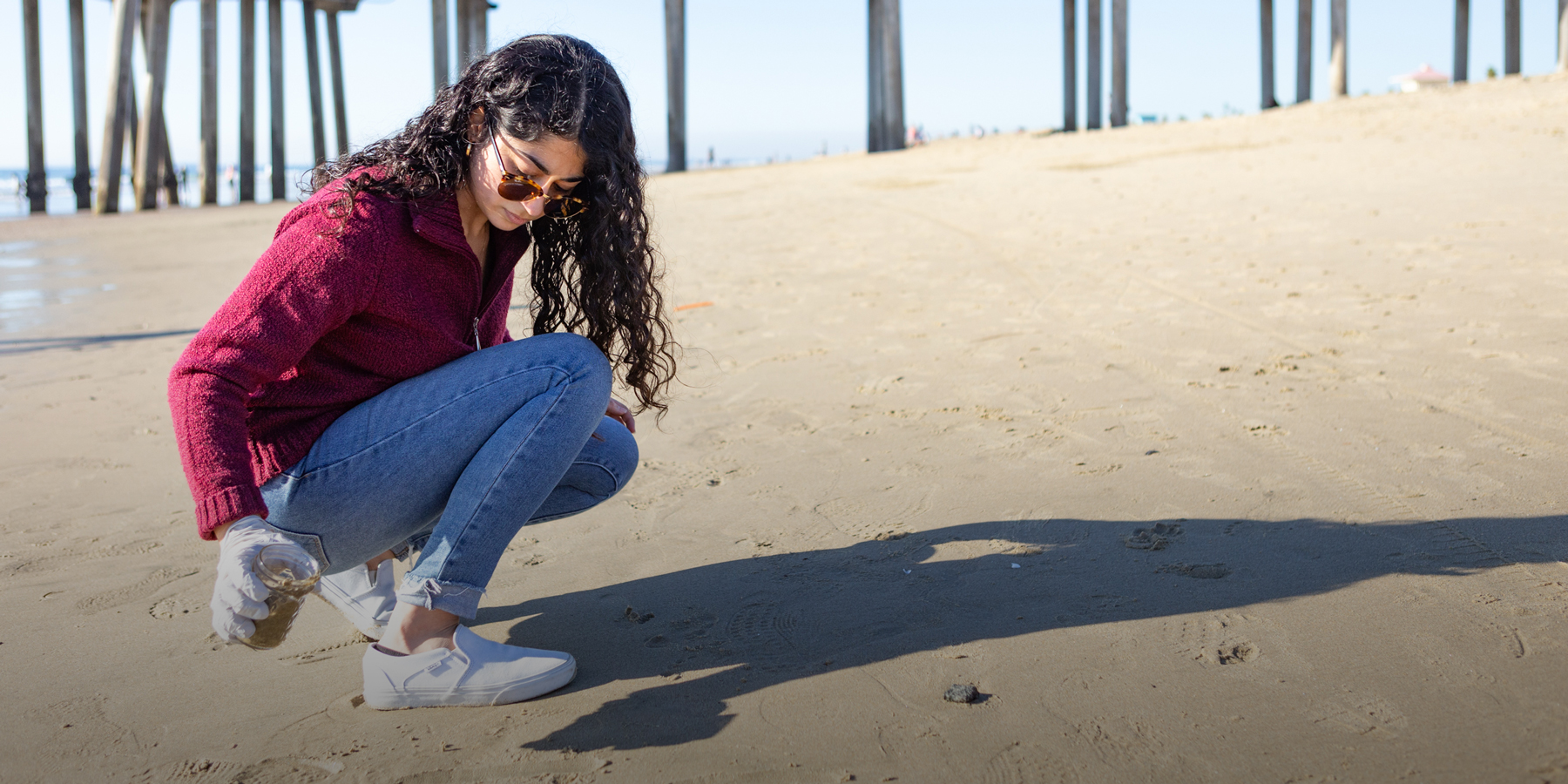
Looking out for the coast
With funding from COAST, these CSU faculty members launched new research projects in response to the October 2021 Huntington Beach oil spill.
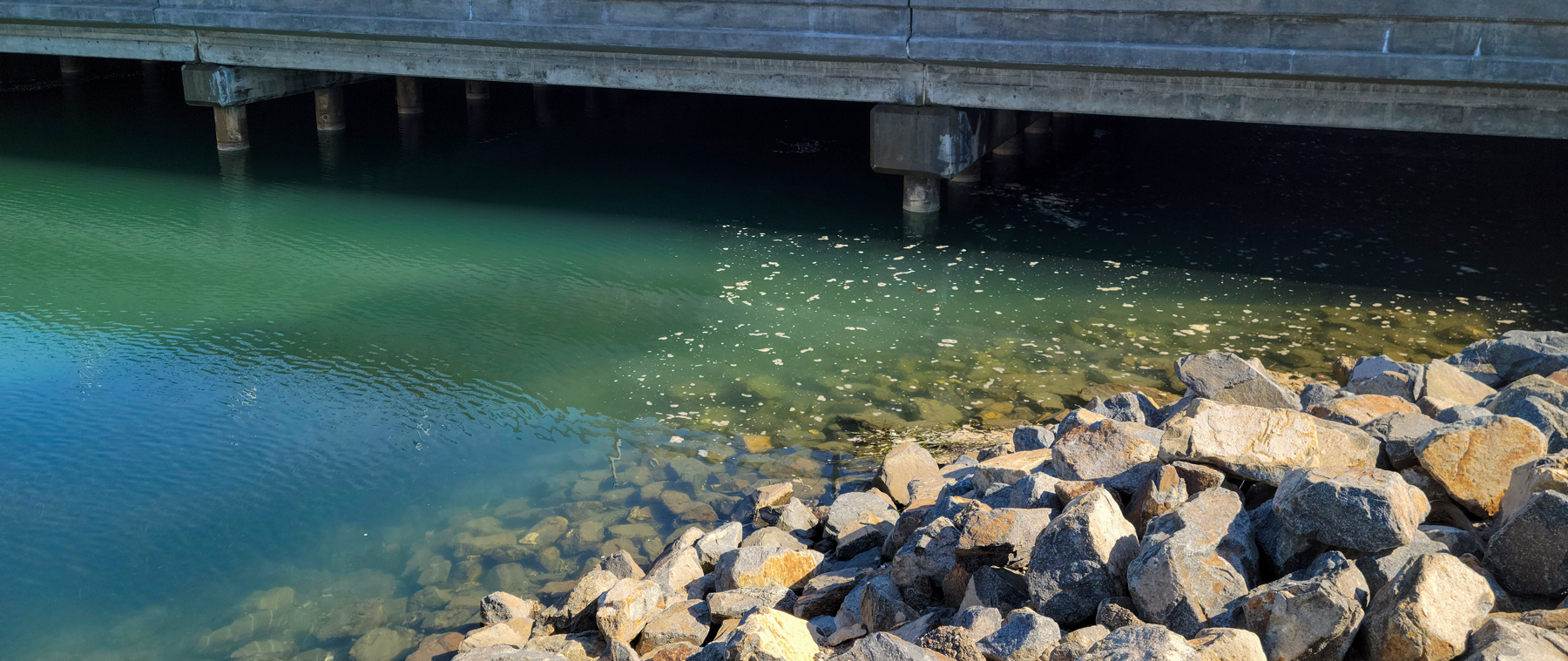
A Look at the oil
Coastal wetlands are sensitive and complex environments where oil entering the system could potentially affect many components of the ecosystem, including microbial communities, shellfish, fish and other wildlife.
To assess pollutant levels and their effects following the Huntington Beach oil spill,
California State University, Long Beach biology professors, Erika Holland, Ph.D., and Christine Whitcraft, Ph.D., partnered on a project to analyze sediment samples from the Huntington Beach wetlands and Upper Newport Bay.
“We're looking at the increase in contaminants right after the spill and then researching how long it takes to go back to pre-spill levels,” Dr. Holland says. “We're interested in knowing exactly what type of pollutants actually ended up in the sediment and in shellfish in those estuaries.”
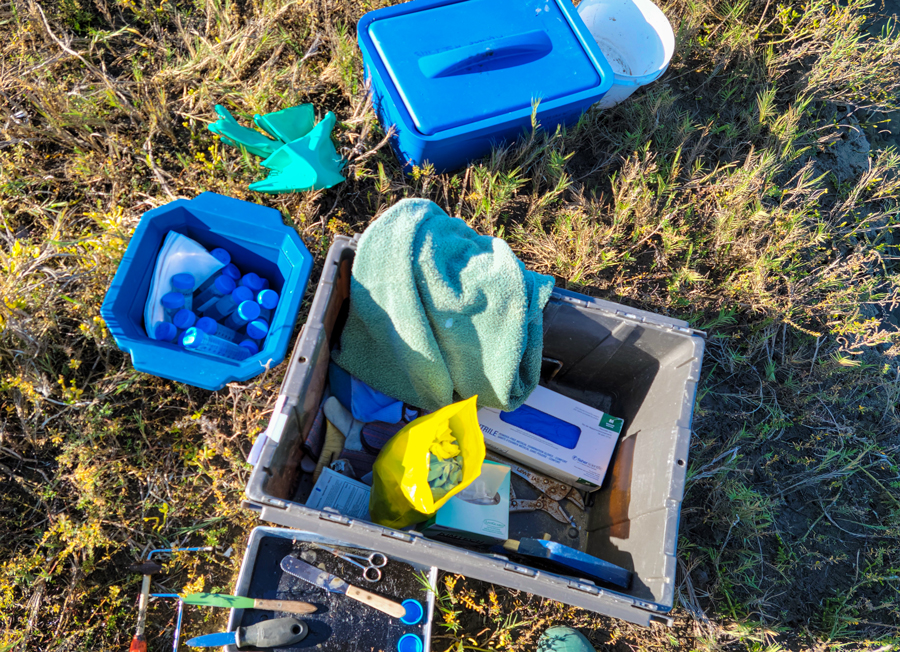 The research team sets out their gear to collect sediment and oyster samples.
The research team sets out their gear to collect sediment and oyster samples.
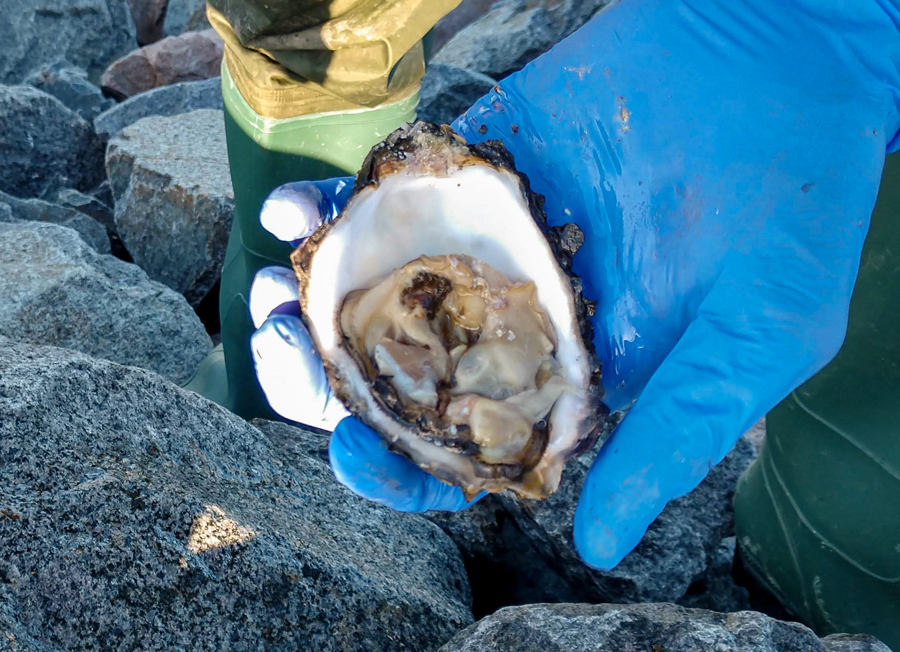 Graduate student Aaron Sugimoto, who works with Dr. Erika Holland, holds one of the oysters being studied in the Huntington Beach Wetlands Complex.
Graduate student Aaron Sugimoto, who works with Dr. Erika Holland, holds one of the oysters being studied in the Huntington Beach Wetlands Complex.
Along with a team of students in her
toxicology lab, Holland will gather and analyze the samples over the course of a year. The researchers will look at the chemicals present within the samples to see how much the spill has contributed to pollution and compare the findings to other samples collected before the oil spill and to data collected from other unaffected estuaries.
With information on the source and levels of contamination among the oyster population, the team can use models to assess how the pollutants from the oil spill may affect oysters and other species that reside in the affected estuaries.
“Wetlands are filters, removing pollutants from water as they pass through the habitat. Thus, understanding the pollutant load and impacts through toxicology is important to understanding how wetlands work and how they interact with developed landscapes,” Whitcraft says. “The research that we are conducting on pollution related to this oil spill helps document one specific potential impact in these systems, but it builds on a baseline of understanding how contaminants in an urbanized landscape can affect organisms themselves, communities and overall ecosystem processes like food web support or reproduction.”
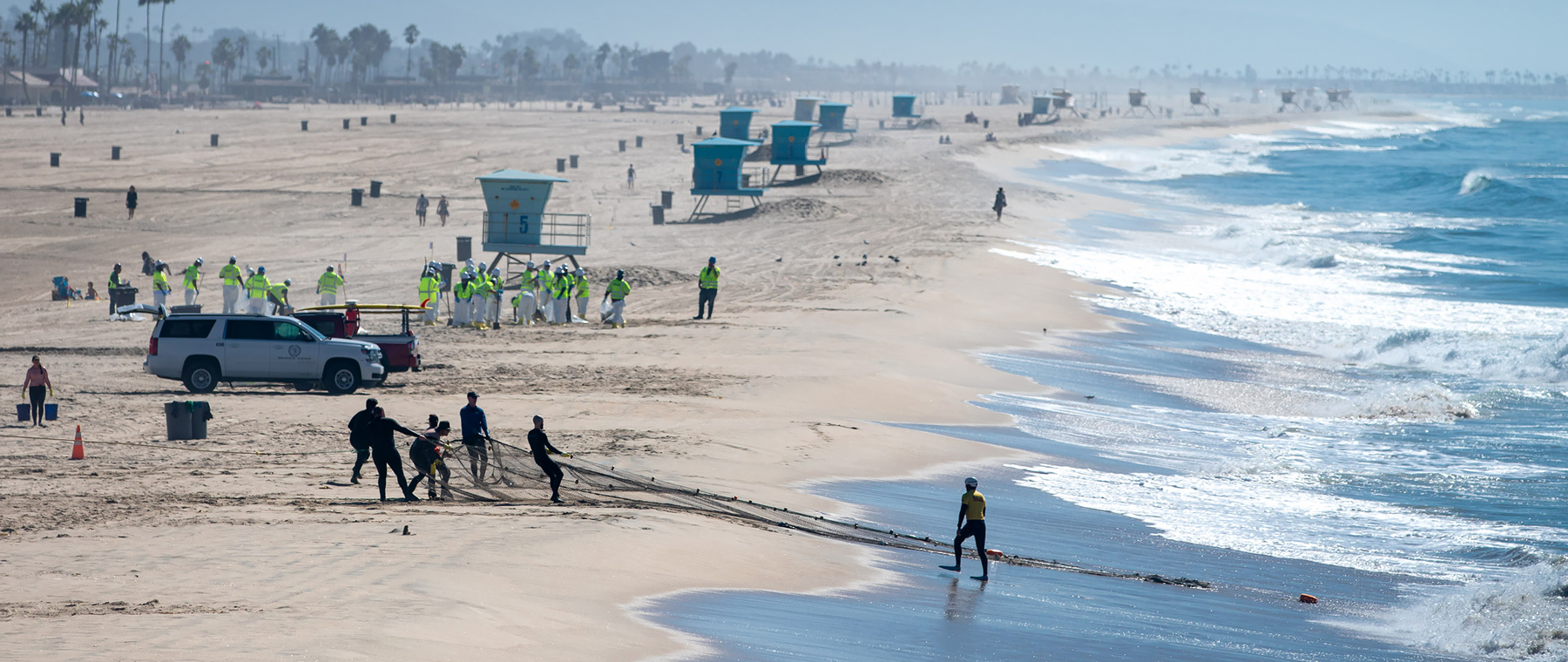
Under the microscope
Whitcraft is also working with Jesse Dillon, Ph.D., CSULB professor of Biological Sciences, to study the spill’s effects on microbial communities in Talbert Marsh in the Huntington Beach wetlands.
“The projects are actually quite synergistic in that we are all evaluating potential contamination in the sediment and how that might impact different components of the wetland ecosystems,” Whitcraft says.
The project grew out of an initial collaboration among Whitcraft’s
CSULB Wetlands Ecology Lab, CSULB’s
Shark Lab, University of California, Riverside and the National Oceanic and Atmospheric Administration (NOAA) to
collect and test fish along the surf line at Huntington Beach just days after the oil spill (pictured above).
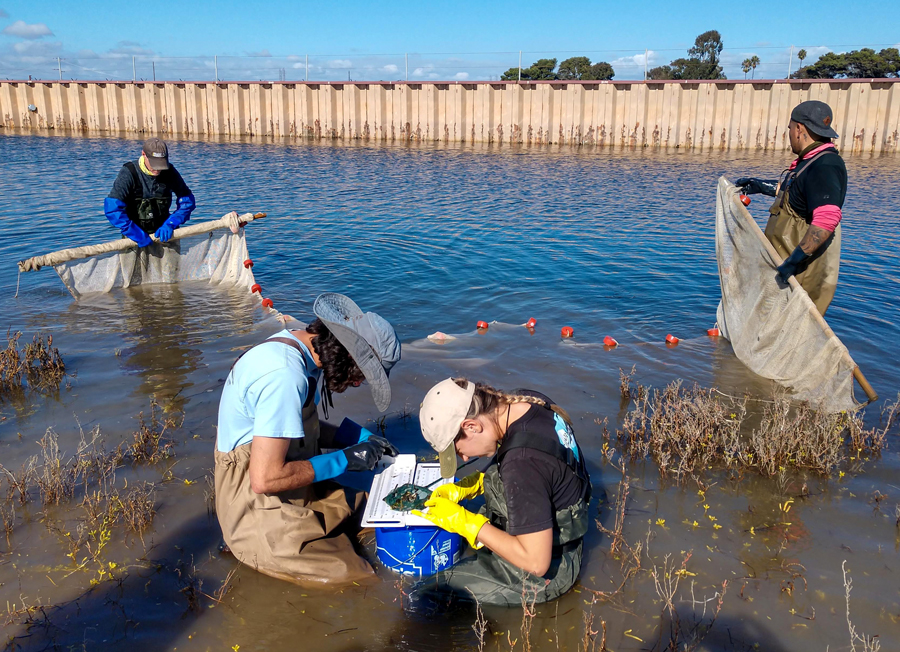 Professor Christopher Lowe, Ph.D., of the Shark Lab, former undergraduate student David Boehmer, graduate student Emily Spurgeon and graduate student Sebastian Garcia, from left to right, capture California Killifish for counting and monitoring after the Huntington Beach oil spill.
Professor Christopher Lowe, Ph.D., of the Shark Lab, former undergraduate student David Boehmer, graduate student Emily Spurgeon and graduate student Sebastian Garcia, from left to right, capture California Killifish for counting and monitoring after the Huntington Beach oil spill.
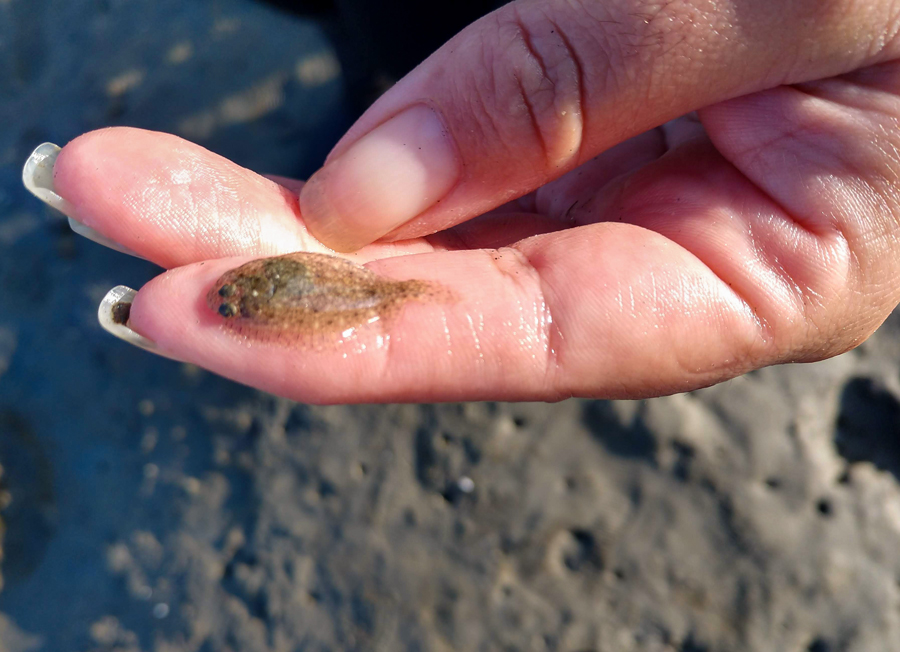 A team member holds a young halibut, caught as part of the post-spill efforts to monitor wildlife in the wetlands.
A team member holds a young halibut, caught as part of the post-spill efforts to monitor wildlife in the wetlands.
“We were called in to help out with the federal efforts to understand the short-term impacts of the oil … and document impacts to any areas where the oil was believed to have reached,” Whitcraft says. “The oil can get into marsh systems, and sometimes the plants and invertebrates can be smothered or experience toxic effects from the oil itself. Long-term, that oil can stay in the sediments, so it's likely that the components of marshes that get impacted the most are actually the microbial community, which is right there at the surface and responsible for a lot of important processes.”
The bacterial communities, though, can prove particularly important in mitigating the effects of the spill. “There are community changes that occur mainly in bacteria in response to the oil, and they can actually decompose it, break it down or degrade it over long periods of time,” Dr. Dillon says.
Sampling at the marsh began a week after the initial effort with NOAA and will take place over a year. Dillon and his students will run tests like DNA sequencing on the samples in his Microbial Ecology Lab. They’ll then compare their findings to other data Dillon and Whitcraft collected that looks at the function of the microbial communities within the food web, as well as the invertebrates, plants and fish in Southern California marshes.
“The biggest implications are going to be to understand how long the oil persists in the marsh and how it changes all the different components of the ecosystem,” Whitcraft says. “The opportunity to get in and sample relatively soon after the spill was something that hasn't always been able to happen in other larger spills. … We think that the amount of information we developed from that short-term access to the samples, as well as a comprehensive look at the different components like microbes, plants, invertebrates and fish, could inform the overall ecosystem impacts moving forward.”
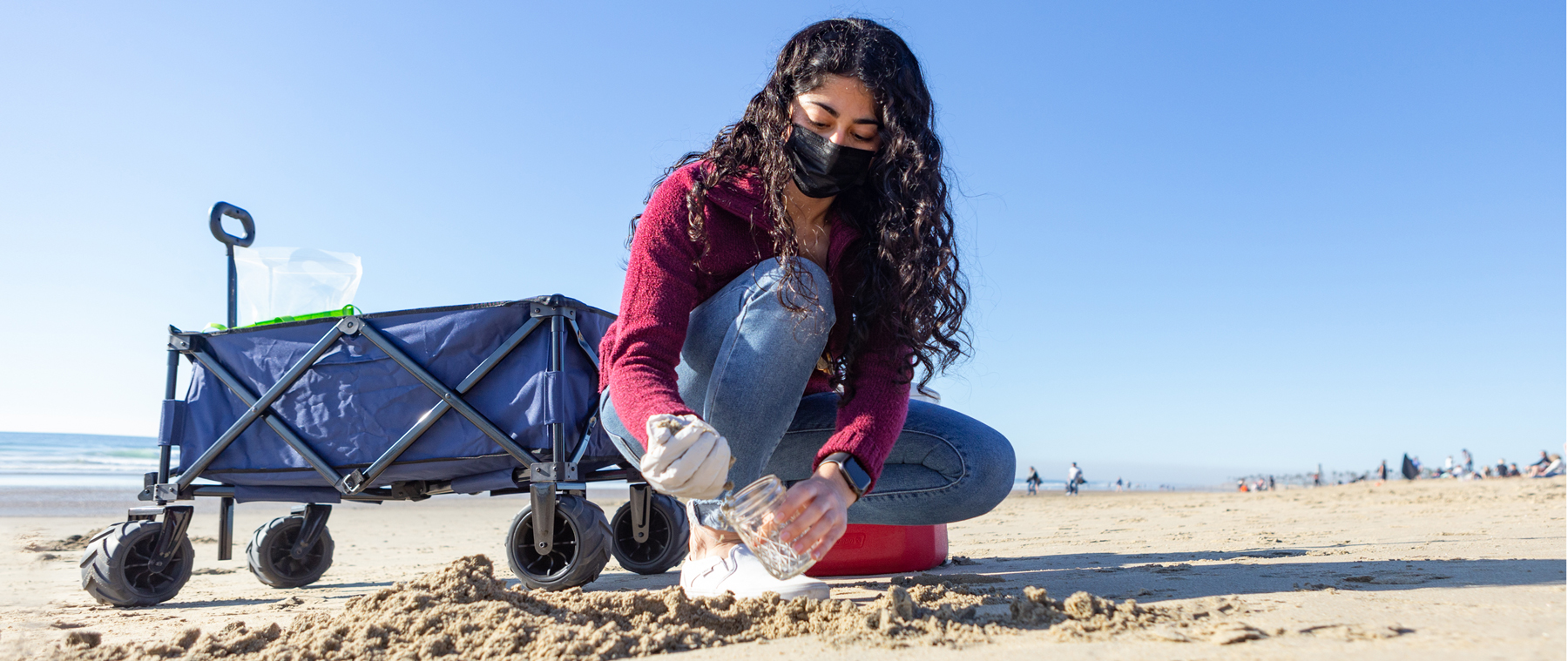
Hands in the sand
But the contamination isn’t hazardous to only plants and animals. Just 10 days after the spill, the beach reopened to the public. For
California State University, Los Angeles Assistant Professor of Chemistry Petr Vozka, Ph.D., that decision raised a question: Was it safe for beachgoers?
“If people are sunbathing in summer when it's [hot], these compounds may evaporate—they are also very volatile or semi-volatile—so the question is if these compounds are still there, how healthy that would be,” Dr. Vozka says.
While it’s common to analyze chemical contamination in the ocean following a spill, there is limited research on the contamination of sand beaches. There are also no protocols for monitoring the effects of oil spills on the sand.
By collecting and analyzing sand samples from two spots at Huntington Beach, Vozka plans to monitor the degradation of oil in the sand. A key challenge for Vozka and the students working in his
Complex Chemical Composition Analysis Lab is the need to develop techniques for measuring that contamination.
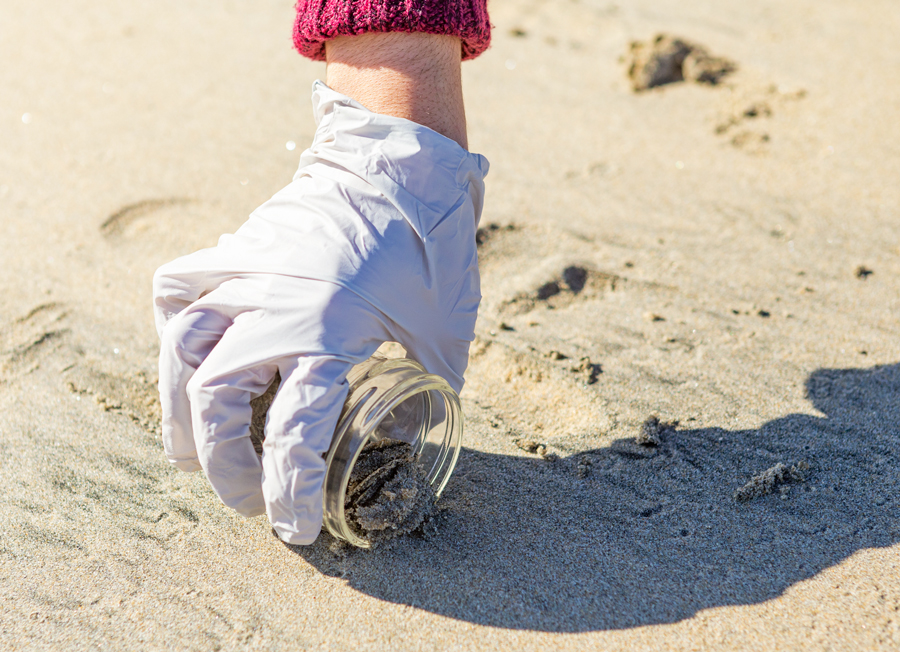 Graduate student Elena Mosham, who works with Dr. Petr Vozka, collects sand samples from Huntington Beach.
Graduate student Elena Mosham, who works with Dr. Petr Vozka, collects sand samples from Huntington Beach.
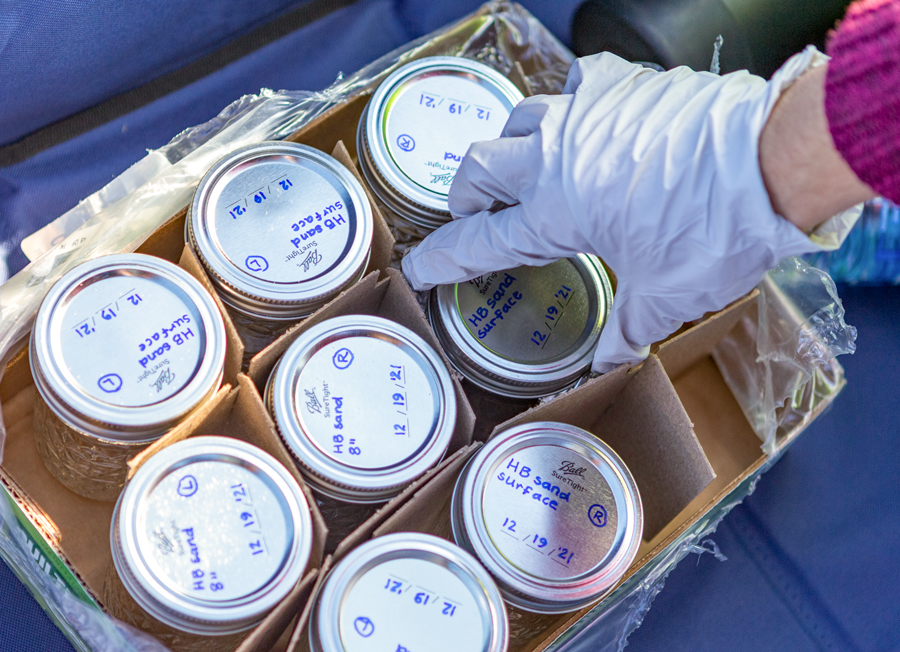 Dr. Vozka and Mosham will take sand samples from the surface and six to eight inches deep at two spots on the beach over the course of a year.
Dr. Vozka and Mosham will take sand samples from the surface and six to eight inches deep at two spots on the beach over the course of a year.
“In my lab, we normally focus on complex mixtures, mostly fuels and petroleum fractions, so this is what we analyze on a daily basis,” Vozka says. “This is a little bit more complicated because we need to extract the compounds from the sand as we cannot inject or put the sand into our instruments … you can inject liquid or gas samples, but not solid. So, we need to develop a method to extract all compounds from the sand sample and then analyze them via our instruments.”
With a new analytical process, the team could then compare the contamination levels to those at beaches not affected by a spill and better understand the dangers posed by oil-contaminated sand.
“The ocean is washing these sands over and over, so we'll be focusing on monitoring the concentration levels over the one-year period, if the concentrations of some of these [toxic or carcinogenic] compounds are getting lower or disappearing,” Vozka says. “It's not easy to mimic these situations in the lab. This happened very close to my university, so we could start collecting the samples immediately. We are hoping to see what is happening in real life if there is an oil spill and how that actually affects the beaches.”
“This is not the Deepwater Horizon oil spill, but I think it's very important that we do all of these efforts, keep our attention up and run these analyses on all of the components of the ecosystems that are potentially impacted,” says Andrea Bonisoli Alquati, Ph.D., assistant professor of biological sciences at
California State Polytechnic University, Pomona. “We tend to underestimate the effects of these spills and of contamination.”
Since 2015, much of
Dr. Bonisoli Alquati’s research has focused on studying the impacts of the 2010 Deepwater Horizon spill—the largest spill in history, which released about 134 million gallons of oil into the Gulf of Mexico—on shore and marsh birds in Louisiana. Following the Huntington Beach oil spill, he is planning to launch a new project looking at several local shorebirds at various life stages, pending approval from state agencies.
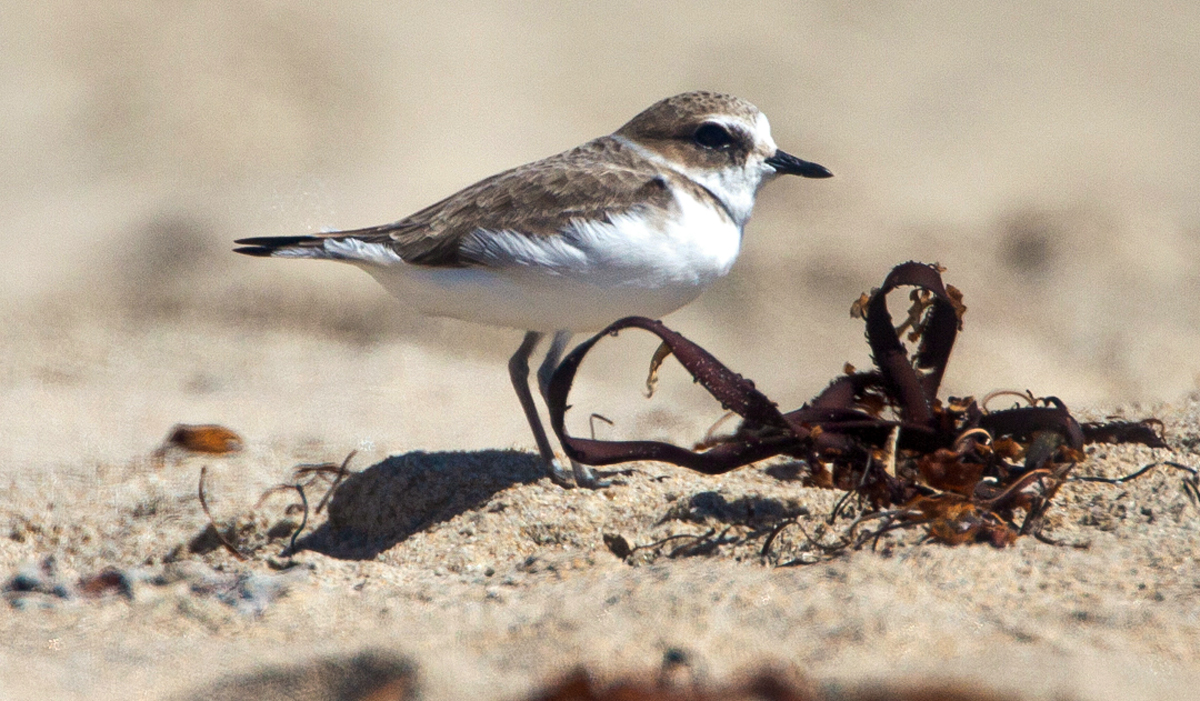 A Western Snowy Plover, photographed by Dr. Andrea Bonisoli Alquati two weeks after the oil spill, rests on a beach near Dana Point.
A Western Snowy Plover, photographed by Dr. Andrea Bonisoli Alquati two weeks after the oil spill, rests on a beach near Dana Point.
“This would be a chance to do things right—not to just be satisfied with a count of birds that have been oiled and rehabilitated or killed, but rather to look into the more subtle effects,” Bonisoli Alquati says. “We now have better science that tells us subtle effects might turn out to be lethal or damaging.
“Very small amounts of oil in birds that might not even have been oiled at all, but came in contact with oil through their feeding or foraging on the shores or in the marshes, are enough to cause an increase in the concentration of these pollutants,” he continues. “We know that that's enough to cause behavioral issues, physiological issues, survival issues and fecundity issues.”
Specifically, he hopes to catch and draw blood from Western Snowy Plovers, an endangered species, to measure their exposure to oil by assessing the associated toxin levels in their blood samples. In addition, he will test pollutant levels in the eggs from Black Skimmers and Forster’s Terns gathered by one of his partners before the spill, which he hopes to compare to data from eggs laid this year.
“If we are to prevent [oil spills] in the future, establish what the true cost of our environmental choices are and improve on our understanding of what happens when accidents like this take place, it's important that we understand the consequences for ecosystems in general,” Bonisoli Alquati says. “Birds are just one piece, but a very important piece, of these ecosystems. We need this [research] for better understanding and ultimately for the accountability that is necessary in order for us to make policy decisions.”
See how teams at
California State Polytechnic University, Humboldt,
California State University, Northridge and
San Diego State University are more broadly addressing oil spills.